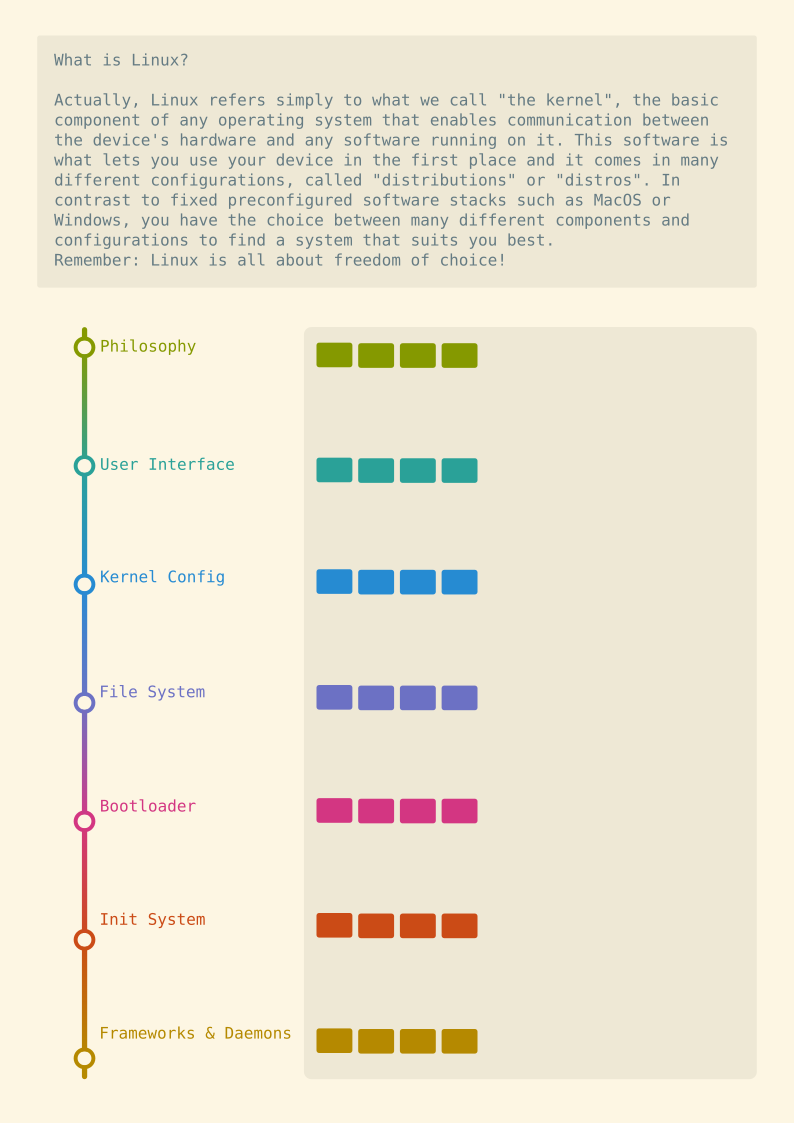We often get the same question with
“I’m new, what distro do you recommend?”
and I think we should make a list/ discussion on what is our pick for each person, and just link that post for them to give them an easy recommendation.
So I made a quick flow chart (will get polished as soon as I get your input) with my personal recommendations. It is on the bottom of the text, so you see the rest of the text here too.
I will also explain each distro in a few, short sentences and in what aspects they do differ and what makes them great.
Here are my “controversial” things I want to discuss with you first, as I don’t want to spread nonsense:
Nobara
I don’t know if we should recommend it as a good gaming distro. In my opinion, it’s a highly insecure and experimental distro, made by one individual. I mean, sure, it gives you a slightly better experience ootb compared to vanilla Fedora, but:
- As said, it’s made by one single guy. If he decides to quit this project, many many people will just stop getting updates.
- There are many security-things, especially SELinux, disabled.
- It’s severely outdated. Some security fixes take months until they arrive on Nobara.
- It contains too many tweaks, especially kernel modifications and performance enhancers. Therefore, it might be less reliable.
I think, Bazzite is the way superior choice. It follows the same concept, but implements it in way better fashion:
- Just as up-to-date as the normal Fedora, due to automatic GitHub build actions.
- No burden of maintenence, either on the user or the dev side.
- Fully intact security measures.
- And much more.
Immutable distros
I’m a huge fan of them and think, that they are a perfect option for newcomers. They can’t brick them, they update themselfes in the background, they take a lot of complexity compared to a traditional system, and much more.
Especially uBlue and VanillaOS are already set up for you and “just work”.
If you want to know more about image-based distros, I made a post about them btw :)
VanillaOS
It’s the perfect counterpart for Mint imo. It follows the same principle (reliable, sane, easy to use, very noob friendly, etc.), but in a different way of achiving that.
The main problems are:
- The team behind it isn’t huge or well established yet, except for the development of Bottles.
- They want to do many things their own way (own package manager, etc.) instead of just using established stuff.
- The current release (V2, Orchid) is still in beta atm.
I see a huge potential in that particular distro, but don’t know if I should recommend it at this point right now.
ZorinOS
I think, for people who don’t like change, it’s great, but it can be very outdated. What’s your opinion on that distro? It looks very modern on the surface and is very noob friendly, but under the hood, very very old.
Pop!_OS
Same with that. Currently, there’s only the LTS available, since System76 is currently very busy with their new DE. I don’t know if we should recommend it anymore.
I made the list of recommendations relatively small on purpose, as it can be a bit overwhelming for noobs when they get a million recommendations with obscure distros.
Do you think that there are any distros missing or a bad recommendation?

Removed by mod
Thanks for the feedback!

Ah shit, I’m 13.
I’m sorry if that’s harsh, but my feedback would be: drop that chart!
It’s daunting, it’s going to freak out many newbies. Too much choice kills the choice.
You have one “default” at the bottom, Mint, so stick to that. Tell the newbies they can switch anytime to something else once they’re a bit more comfortable with the Linux-world. And if I’m not mistaken, you can install and try the main DEs with Mint also. Or you can recommend Ubuntu, or any other newbie friendly distro. Just pick one and don’t lose them over what they could see as an important difficult decision before they even get started.
Yeah this was my thought exactly.
Use ubuntu unless you know why you prefer something else.
Are we still recommending Ubuntu though
Don’t drop the chart! It’s really helpful for some people, and it’s fun, even for people who are looking to branch out rather than start fresh.
Maybe have it start simple, eg. the very top choice is “First distro?” and Y points to a giant friendly MINT endpoint that takes up half the real estate, then N points to the regular cloud of options.
But don’t ignore the benefits of graphical representations. If newbies make it all the way here, they’ve already waded through hundreds of vast, incomprehensible walls of text expounding the virtues of sysv and runit.
I’m not saying dumb it down. There’s plenty of time to dig deeper, let’s ease the initial option paralysis.
I think beginners spend too much time and effort on the “choose a distro” quest. Choosing a DE is far more important than that.
Just that you need a Distro packaging that DE. I chose KDE and never switched, but I hopped distros as they where either too old, or broken, or unstable.
5.27 on Kinoite is pretty great though. Would recommend and I think Kubuntu etc. staying with it do the right thing.
Plasma 6 works pretty well too though, so it was many many KDE problems. But as switching DE was no option, I hopped Distros.
You need to seriously up the contrast on those colors. Pink text on a slightly lighter pink text block is virtually unreadable.
The graph was just a quick sketch in my note-taking app Logseq.
I mainly wanted to know if the flowchart made sense. When I do it properly, I’ll use a different software :)
I’ll let you know if it makes sense when I can read it 😁
Right now this is literally what I see:

I’m very sorry! This is just a sketch for discussion, the final version will look WAY better and be more legible :)
Ohh no apology needed. I think doing it as a flow chart is a good idea. I just included the screenshot to make sure there wasn’t something going on where the colors were different for you vs everyone else.
I don’t have any specific beef with your chart but I do feel like we sometimes do a disservice to newbies by focusing on distros rather than the main desktop environments and what differentiates them. I wouldn’t hesitate to recommend basically any of the Fedora spins or Debian-based distros to beginners.
The choice between KDE, Gnome, Cinnamon, etc. is much more consequential for a new user than DNF vs. Apt (especially in the Flatpak era).
Debian and OpenSUSE Tumbleweed should be in there somewhere.
Do you think that those are great beginner distros?
I think TW is a very good distro, but not specifically for beginners. In your opinion, what redeeming qualities does it have for that use case, compared to other, more well known distros out there? I especially think that the rolling release is not needed for the beginning.
For Debian, same thing. I mean, especially since the newest release, it’s definitely a better ootb-experience than it was before, BUT:
- the installer (first impression) is very ugly and needlessly complicated
- Zorin has a similar release schedule, but looks better by default (Debian is very vanilla) and has some very useful tools for beginners specifically.
- Debian is relatively lean, which might be good for intermediate and advanced users, but for noobs, I quite like the idea of “bloat”, aka a lot of pre-installed software.
Well, TBH I’m far from a distro hopper so I’ll leave comparing install experiences to those who have experience with that.
That said, Debian was the first distro I’ve hopped to from Conectiva, back in the late nineties / early aughts. So the Debian installer asks you for a few more questions. I don’t think that’s a big deal, and if the newbie thinks it is, perhaps they need some help installing any distro.
The absolute stability of Debian is a great asset for a newcomer. I remember the absolute bliss and relief that everything just worked on it. Not like my previous experience with Linux and definitely not like Windows. This newfound stability emboldened me try new things - new DEs, new apps, everything! This is perfect for a newcomer. The only thing preventing me from getting more stuff was my dial up bills and my hard drive.
I also chose Debian back then because of the restrictions of the DFSG. I wanted to have a completely free system and Debian delivers an awesome free system.
Back to Tumbleweed. It’s not your run of the mill rolling release. Their packages receive a lot more testing and it’s considered a very stable distro for desktops. Like the other commenter said, the right integration with Btrfs snapshots is awesome. All package operations are preceded by an automatic snapshot. Recovering from a snafu is quick and painless. So, though a completely different route, it’s also a great distro to try new stuff.
Tumbleweed also has the advantage of OpenSUSE’s philosophy of being able to configure everything graphically. Their YaST2 control panel is a great piece of software, if a little daunting.
So, while I wouldn’t say they are for everyone, I do say they are great beginner distros, for the right beginners. Debian for those that don’t care for the newest version of programs and just want the system to always work (and want to get free from proprietary software as much as possible). Tumbleweed for those that do want the newest versions but want peace of mind and GUI configuration.
The Tumbleweed installer is beautiful, and straightforward. I am not sure how a newcomer would understand, or not, the partition setup if they need to keep windows and dual-boot ; if it’s about to wipe the entire machine, it is one of the best, sleekest installers out there. Then package management can be a nightmare if you need to stray out of he beaten path unfortunately. Another argument for TW is the perfect integration of BTRFS, Snapper and Rollback (it is an opensuse project after all) ; I swear I’d still be on TW if it wasn’t for some exotic software availabiity.
To me, debian does bring bloat: LibreOffice comes to mind. A default install will feature calendars, mails, weather whatever.
Here’s a revised flowchart for you:
- You need professional software like MS Word, Autodesk, Adobe, NI Circuit Design for collaboration with others > Stick with windows;
- Any other case > Install Debian + GNOME + Software as Flatpaks. You’ll get a rock solid system with the latest software;
Done.
deleted by creator
Yeah, the Nvidia bug caused me A LOT of headache. I love Debian, but I really only use it as a server OS. On my workstations, I prefer to have easier compatibility with new hardware and software.
Debian 12 has had at least two system breaking bugs in the last month or two,
What are you talking about specifically? I do manage dozens of Debian 12 servers and run it in one of my desktop machines since the release I didn’t run into any issues so far, stable as usual but I would be interested in knowing about those.
I honestly don’t understand the love for Debian either.
Because, like Ubuntu, it’s truly community driven, not subject to the whims of some corporation and more stable than the others.
Also recommending GNOME to anyone used to Windows is just going to frustrate them if they’re already hesitant.
While I get your point and I like XFCE very much, the “what you go for it’s entirely your choice” mantra when it comes to DE is total BS. What happens is that you’ll find out that while you can use any DE in fact GNOME will provide a better experience because most applications on Linux are design / depend on its components. Using KDE/XFCE is fun until you run into some GTK/libadwaita application and small issues start to pop here and there, windows that don’t pick on your theme or you just created a frankenstein of a system composed by KDE + a bunch of GTK components;
Word I think is the easiest to give up, there are other word processors that are at least as good, they’re only “problem” is they aren’t MS Word.
there are other word processors that are at least as good
Their only problem is that this isn’t true. :P LibreOffice and friends might work for quick jobs in isolation and whatnot but once you’ve to collaborate with others and use advanced features like macros it’s game over.
For what’s worth LibreOffice can’t even keep the default spacing on a bullet list consistent with what MS Word does and this is an issue if you share a document in works with someone else and then things appear in different places / pages.
That’s what I meant by “They aren’t MS Word.” The problem is MS Word is the one everyone else has and those slight differences where “Looks fine on my machine” but looks weird when the teacher sees it.
As for “advanced features like macros” who the fuck uses macros in MS Word? I’ll believe it in Excel but in Word?
LibreOffice, OnlyOffice, hell Abiword is probably good enough to get practically everyone through a bachelor’s degree writing MLA formatted essays; if you need to get more serious than that you should be learning LaTEX.
sorry if this is harsh but this seems like kind of a waste of time when distrochooser.de exists? I think it’d make a ton of sense to link that in the sidebar but a wall of text (or a huge flow chart) is just gonna be skipped by the type of people who are asking what distro to use first instead of researching it themselves anyway. if someone’s asking in a forum like Lemmy or even in discord servers, they usually just want quick answers. if we’re gonna link them something instead of just saying “mint” or whatever, it should at least be something easily digestible like distrochooser.de
BTW you got a bunch of weird distros no one has heard of and you don’t have the champion of distros. “Do you know how to read and follow directions and do you like the stack overflow answers that are the shortest -> arch”

Not everyone has mad CPU resources (or time) to support portage tho.
What do you mean with weird distros?
TuxedoOS is basically the same as Pop or Mint.
Based on Ubuntu, but without Ubuntu shit (Snaps, etc.), focused on newcomers, and with KDE.And Fedora Atomic (Silverblue, Kinoite, Bazzite, uBlue, etc.) are the same. They’re the immutable versions of Fedora. Silverblue is the Gnome variant, Kinoite the KDE one, uBlue a community project with some QoL-tweaks, and Bazzite is the gaming variant.
Nothing weird there. I basically only provided a small bunch of identical distros with other DEs.
My prefered OS is missing. Must be a bug. Plz add NixOS kthx
Already done in the final version ;) But you won’t be happy, I’ve put it into my “pain”-category :D
Guix > Nix, because I’m more angry about not being able to run the former than the latter.
Instead of “use anything” you could put in “Debian.”
What do you think about something like this? It’s more of a “build your own sandwich” approach.

What about recommending something like MX Linux if someone has an old laptop lying around and wants to revive it, and get into Linux this way?
And the question “Win 7 was the last good version” made me laugh. I remember the old times. All the viruses on XP… but it used to crash way less that it’s predecessors. Vista which was super slow and annoying. Feels like they’re making some progress since 7. (Okay, now they’re adding more and more data collection and annoyances to it.) But if I look back to Windows 7… I’m not feeling nostalgia 😆
Good idea. I’ve never used it or saw it recommended that much.
Can you tell me more about it?
Do you think there’s a big need for laptops with way less than 4 GB RAM? I’d say no, because there are barely any this old devices around, and most people here ask for their gaming PC or a mid range laptop.
I’m just afraid people tend to overestimate their need to choose a “lightweight” distro and then complain that it feels old and barebones and that “Linux sucks, I go back to Windows because Steam behaves weird”.
Can you tell me your experience and provide more information?
Uh, my knowledge is a bit lacking. But I’ve been asked that question before. I don’t think there are that many devices with less than 3GB around anymore. And they’re probably 32bit, too. And have all kind of other issues, like modern webpages being way more demanding than in 2003. I’d skip all the details, people know what feels old and needs special treatment. If someone has an Athlon K7 with 512MB of RAM, they either need to get it recycled or a dedicated tutorial for that. Everything above should be handled by a good (32bit) distro with LXDE, LXQT, XFCE or something like that.
I think MX Linux is a good choice. I’ve also used a plain Debian with XFCE desktop for that. Other choices include: Bohdi Linux, Zorin OS Lite, AntiX, Linux Lite, Puppy Linux, Q4OS, LUbuntu, Linux Mint Xfce, Tiny Core, LXLE, Slax, peppermintOS, crunchbang++ and Sparky Linux.
You need to limit the options.
Linux systems
-
Debian (stable, almost no bloatware, user unfriendly, apt)
-
ArchLinux (unstable, bleeding edge software, user unfriendly, pacman)
-
RHEL/ Fedora (semi-stable, newer software, relatively user friendly, dnf)
Then at max list 3 Systems that derive from each main OS.
Like
Debian: Ubuntu, Mint, PoP!OS ArchLinux: manjaro… Fedora: Nobara…
Where each should be user friendly to use. Also explain what stable means, like that unstable doesn’t mean shit breaks on a regular basis but rather it can sometimes happen. Normal desktop users don’t need the stability of Debian. But it is nice to have if you can live with outdated software (if it isn’t already on flatpak).
-










